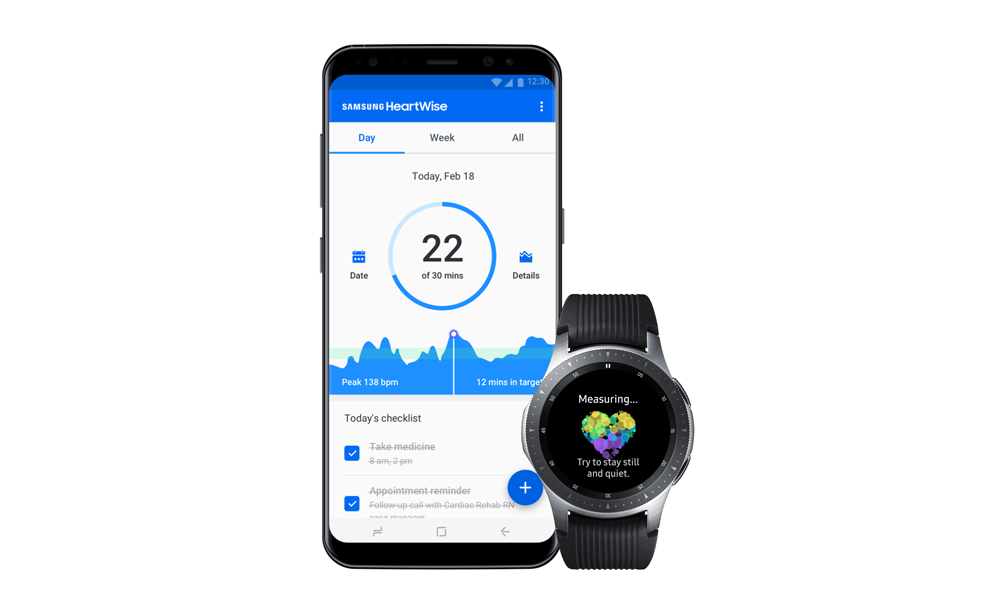Samsung-Kaiser Improves Home-Based Cardiac Rehabilitation
The smartwatch-based program delivers customized information and monitoring.

A partnership between Kaiser Permanente and Samsung Electronics Co., Ltd., has resulted in a next-generation cardiac rehabilitation solution that shows promise for better patient outcomes. It is built around Samsung’s smartwatch and patient-facing companion HeartWise mobile application.
The eight-week cardiac rehab program complements patients’ schedules and offers clinicians the ability to remotely monitor and provide feedback to patients. Details of the joint initiative were published in the New England Journal of Medicine (NEJM) Catalyst.
According to Samsung, results of this initiative show significant improvements over traditional cardiac rehabilitation programs. “This program took a fresh, digital-first approach to cardiac rehabilitation and put control in patients’ hands,” says Peter Koo, corporate SVP and head of the Health Service Team, Mobile Communications Business at Samsung Electronics. “It produced higher program completion rates than programs requiring excessive trips to the doctor’s office.”
First, Samsung developed a patient-facing mobile app, designed to pair with a specially configured smartwatch. Then, with Kaiser Permanente, a pilot program was launched in Riverside, California, with a cohort of 37 patients. After being referred to cardiac rehab by a physician, patients attended a face-to-face consultation, where they were evaluated by a clinician and issued a smartwatch. Participants used the wearable device to select their preferred type of exercise, describe their symptoms, and self-assess their fitness level. This data was subsequently transmitted to a clinician dashboard, where providers could set fitness goals for their patients and monitor progress.
Related: The Future Of Healthcare Wearables
In the subsequent seven weeks following their initial visits, patients participated in regular phone calls with case managers and virtual visits that included coaching, counseling, and mental health screenings. Over time, the program was expanded to 12 of Kaiser’s Southern California sites, growing to almost 2,400 participants. Kaiser is now evaluating expansion of the program beyond Southern California.
“Compared to existing rehab options-including home-based and site-based care-our virtual regimen has increased rehab graduation rates from 50% to 87%. Additionally, two-thirds of our participants are exercising every day, and only 2% were re-hospitalized in the months following program completion-down from 10% to 15% in traditional cardiac rehab programs,” says Natalie Schneider, VP of digital health at Samsung Electronics America.
“Our smartwatch solution didn’t just monitor participant progress-it also provided patients with important information over the course of the program,” Schneider says. “Based on specific comorbidities, smartwatches pushed custom-tailored information to each patient about potential seminars of interest. We found that these suggestions did not go unconsidered. Though each participant was required to complete a video education program on nutrition and exercise, nearly 40% opted in to additional in-person classes on topics like sleep and stress management.”
“Over the next decade, wearables will become increasingly indispensable to the healthcare space. By tracking fitness habits and patterns, they’ll continue allowing patients to take better control of-and make better decisions about-their health,” Schneider says. “As the technology behind these devices improves, they can serve as both monitoring and diagnostic tools for cardiac care, and they’ll also help advance telehealth services and enable physicians to do more from afar.
“Our findings highlight the importance of smart, conscientious design in medical technologies,” she adds. “If executives want to maximize the impact of their programs, devices, and therapies, they need to understand how patients will interact with their product both inside and outside the clinical setting.”
*Cover image credit: Samsung
In the Scope of Virtual Health and the Future of “Website” Manner, Per Ateev Mehrotra
August 10th 2023Briana Contreras, an editor of Managed Healthcare Executive, had the pleasure of catching up with MHE Editorial Advisory Board Member, Ateev Mehrotra, MD, MPH, who is a professor of healthcare policy at Harvard Medical School and an Associate Professor of Medicine and Hospitalist at Beth Israel Deaconess Medical Center.
Listen